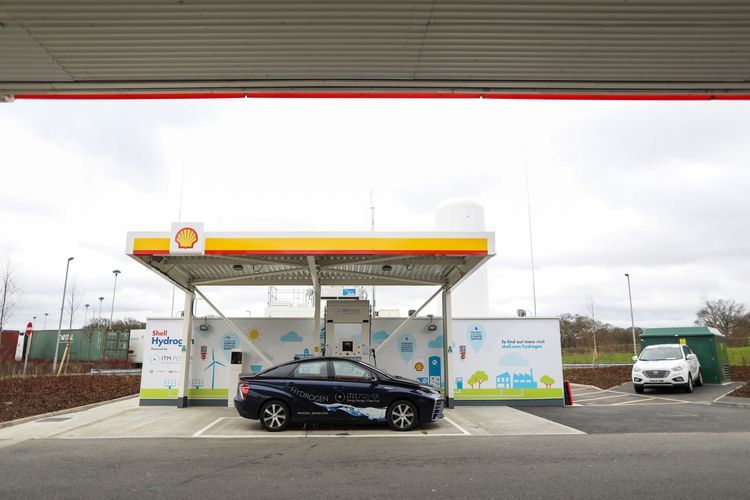
Taxi driver Theo Ellis, the first person in Europe to drive Toyota Motor Corp.’s hydrogen-powered Mirai sedan for business, loves telling passengers about the technology that emits nothing but water.
They ask him about its costs, greenness, and the majority inquire about safety. To his passengers, the word “hydrogen” evokes memories of the Hindenburg, the airship that was destroyed in half a minute when it caught fire in 1937, or the H-bomb, a successor to what the U.S. dropped on Japan to end World War II.
“That will put people off,” Ellis, who drives for London-based Green Tomato Cars Ltd., said in an interview. “A lot of people mention that. As soon as you mention hydrogen it’s the first thing on their mind.”
It’s those perceptions that represent one of the biggest hurdles for Toyota and Royal Dutch Shell Plc as they seek to make hydrogen fuel cells a commercial alternative to gasoline-powered cars around the globe. The Japanese automaker and the European oil producer are among the most prominent advocates of the technology, which they see as safer and less polluting than the fossil fuels that cause global warming.
Iconic Disaster
Use of the lightest element has come a long way since the Hindenburg disaster in New Jersey killed 36 people and was immortalized on the front cover of Led Zepplin’s 1969 debut album. Fuel cells have been used safely for generations, most famously in the U.S. space program. The cells set up a chemical reaction between the fuel and oxygen in the air, making an electric charge and leaving behind water vapor.
There’s plenty of differences between the Hindenburg and the Mirai, starting with the durability of the storage tank.
In the ill-fated airship, hydrogen gas was contained in giant bags made of coated cotton. Toyota’s tank is made of carbon and glass fibers and lined with plastic. If gas leaked, sensors would detect it and shut down the car. Shell reckons that in a crash, hydrogen is likely to evaporate while gasoline risks forming a puddle that’s easy to ignite.
Not the Same
People who work with fuel cells say comparisons with the Hindenburg aren’t fair. Eighty years after the 245 meter German airship exploded and plunged to the ground, the exact cause remains a mystery.
“The fire and explosion at Hindenburg was nothing to do with hydrogen, and that is the mindset you’ve got to change with people,” said Jon Hunt, who is in charge of commercialization of hydrogen fuel-cell vehicles for Toyota GB Plc. In the airship disaster, “there were a number of things, including materials used and operational practice that would be totally mitigated by normal good practice now.”
His hope is that people will trust the technology to keep them safe just as they do with mobile phones. People continue to carry lithium-ion powered handsets even after Samsung Electronic Co.’s Note 7 smart phones caught fire last year and Boeing Co. planes had fires started by battery units.
Fuel cells are starting to take hold, and not just in cars.
In Japan, companies including Panasonic Corp. are selling thousands fuel cells to power individual homes. U.S. listed companies such as FuelCell Energy Inc., Plug Power Inc. and Ballard Power Systems Inc. are putting them into fork lifts and commercial power generators. Automakers including General Motors Corp. and Volkswagen AG have joined Toyota in designing fuel-cell cars. About 2,800 Mirais were sold worldwide in the last year.
Shell’s first hydrogen pump in the U.K. opened at a filling station outside London on Feb. 22. Fuel is made onsite in an unit supplied by ITM Power Plc, which passes live wires through water to extract hydrogen.
Shell’s Outlook
Shell Chief executive Ben Van Beurden expects the fuel to drive trains, planes and trucks in the future. Trucks are a big potential market, since the batteries they’d need to move by electricity would be too heavy.
While electricity is notoriously difficult to store, hydrogen gas is easily kept in a tank and transported anywhere in the world, the executive notes. To demonstrate this, Shell plans to bring a tanker full of liquid hydrogen to Tokyo in time for the Olympic Games in 2020. The city is spending 45.2 billion yen ($400 million) on fuel-cell subsidies, hoping to deploy 100 buses using the technology at the games.
“The beauty of hydrogen is that it can be made from so many feedstocks,” said Claire Curry, Bloomberg New Energy Finance analyst in New York.
The reality of hydrogen fuel cell vehicles is that it is still an early-stage technology, dependent on government support to spur the refueling network needed. Shell’s most optimistic scenario is to be supplying hundreds of tons of hydrogen to the cars by 2030, says Matthew Tipper, vice president of New Fuels. The Mirai tank holds 5 kilograms (11 pounds) of hydrogen, which gives it a range of about 340 miles.
“The acid test is how many more fueling stations they put in,” said Julia Thomas, managing director of Green Tomato Cars.
Recommended for you
